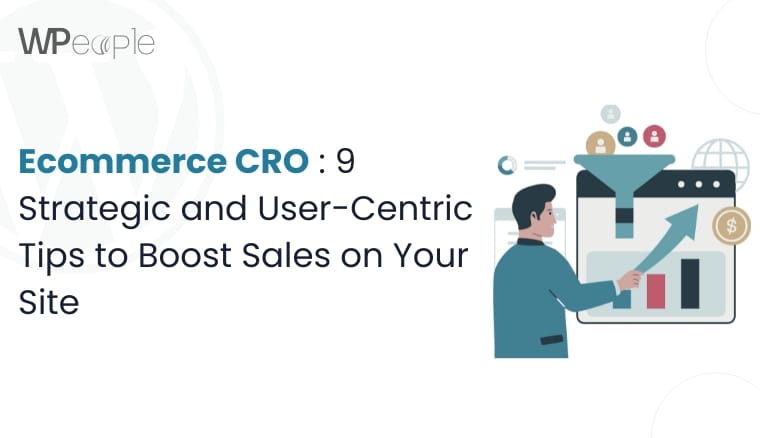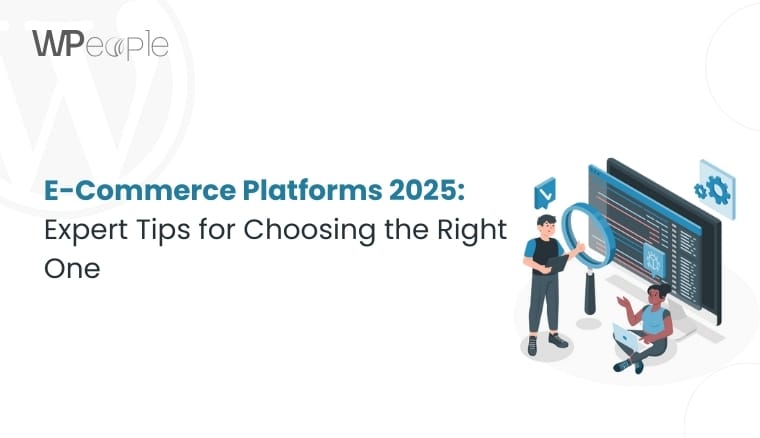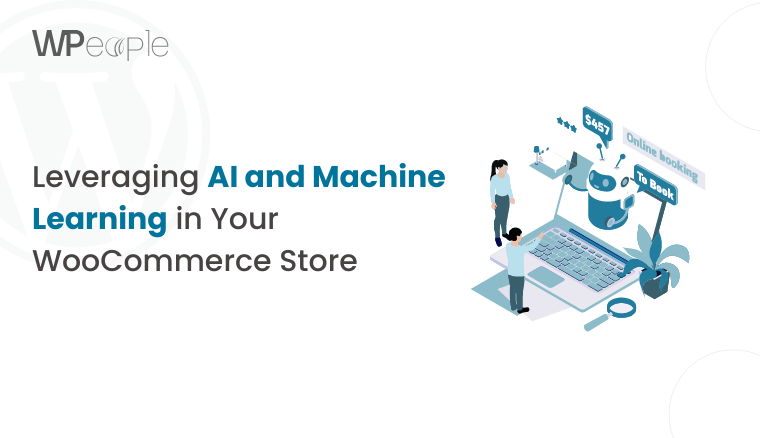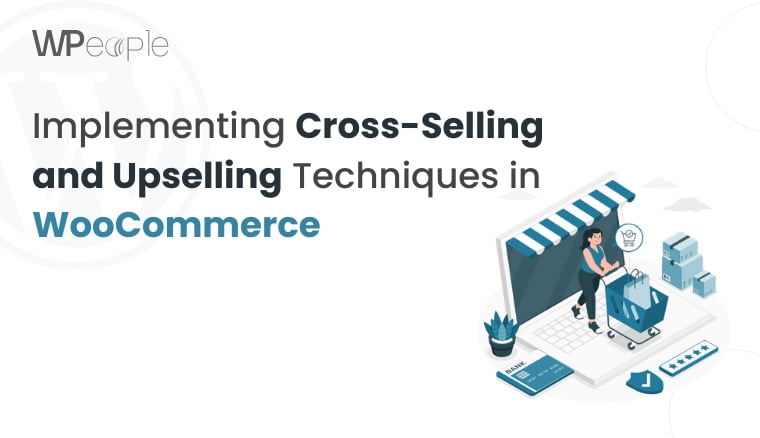
The Hidden Revenue Goldmine in Your Existing Traffic
Your ecommerce site receives thousands of visitors monthly. Yet, most leave without purchasing. This isn’t a traffic problem it’s a conversion problem, and solving it unlocks revenue you’re already paying to attract.
Ecommerce CRO (Conversion Rate Optimization) represents the most cost-effective growth strategy available to online retailers. While competitors burn budgets acquiring new traffic, savvy businesses focus on converting visitors they already have. The mathematics are compelling: increasing your ecommerce conversion rate from 2% to 3% generates 50% more revenue from identical traffic levels.
At WPeople, we’ve analyzed conversion patterns across hundreds of ecommerce implementations. Through this work, we’ve identified that successful conversion rate optimization ecommerce strategies share nine core principles each addressing specific psychological triggers and technical barriers that prevent purchases.
This guide distills real-world learnings from actual store optimizations, not theoretical best practices. Moreover, these tactics combine behavioral science, technical performance, and user experience design to create measurable sales improvements. Whether you’re running a WooCommerce store or any ecommerce platform, these ecommerce conversion optimization strategies will transform how effectively your site converts browsers into buyers.
“In ecommerce, the battle isn’t just about attracting visitors it’s about creating experiences compelling enough to transform casual browsers into confident buyers.”
1. Master Micro-Moments: Optimize Decision Points That Actually Matter
Most cro ecommerce guides focus on broad optimizations. However, conversions happen in specific micro-moments split-second decisions where customers choose to proceed or abandon. Identifying and optimizing these precise moments creates disproportionate conversion improvements.
The Psychology of Decision Architecture
Human brains make thousands of micro-decisions during online shopping. Each decision point either builds momentum toward purchase or creates friction that compounds into abandonment. Therefore, effective ecommerce website optimization requires mapping these moments and systematically reducing hesitation.
Critical Micro-Moments in Ecommerce Journeys
The First-Impression Decision (0-3 seconds): Visitors form judgments about credibility within three seconds. Consequently, your above-the-fold content must immediately communicate value, professionalism, and relevance. Test different hero sections showing actual products versus lifestyle imagery to discover what resonates with your specific audience.
The Product-Click Decision: When browsing category pages, customers decide which products warrant deeper investigation. High-quality thumbnail images, clear pricing, and immediate value indicators (badges like “bestseller,” “free shipping,” or “4.8★ rating”) significantly impact click-through rates.
The Add-to-Cart Decision: This represents the highest-friction moment on product pages. Address it by positioning trust signals within thumb-reach of the CTA button, showing real-time inventory levels to create urgency, displaying return policies directly on product pages, and including size/fit predictors for apparel to reduce uncertainty.
The Checkout-Initiation Decision: The transition from cart to checkout sees massive drop-off. Reduce friction by displaying full cost transparency before checkout begins, offering guest checkout prominently, showing security badges, and enabling one-click checkout for returning customers.
Implementation Strategy
Map your customer journey and identify where the largest percentage drops occur. Subsequently, focus optimization efforts exclusively on these high-impact moments before addressing lower-priority areas. This targeted approach delivers faster ROI than broad, unfocused improvements.
WPeople Insight: Through conversion funnel analysis, we’ve found that optimizing just three micro-moments product selection, add-to-cart triggers, and checkout initiation typically captures 70% of available conversion gains. Start there before expanding efforts elsewhere.
2. Implement Performance-First Architecture (Speed IS Conversion)
Page speed isn’t a technical nicety it’s a fundamental conversion rate optimization ecommerce driver. Amazon calculated that every 100ms delay costs them 1% in sales. For smaller retailers, the impact is even more pronounced because you lack the brand loyalty buffer that protects enterprise retailers from performance penalties.
The Real Cost of Slow Loading
When pages take longer than three seconds to load, 53% of mobile visitors abandon immediately. Moreover, even visitors who stay convert at dramatically lower rates because perceived slowness undermines trust and creates frustration that persists throughout the shopping session.
Technical Performance Optimization
Strategic Caching Implementation: Deploy multi-layer caching including browser caching for static assets, page-level caching for unchanged content, object caching for database queries, and CDN caching for global delivery. Properly implemented, caching reduces server load by 80-90% while cutting load times by 60-70%.
Image Optimization Protocol: Images typically consume 60-70% of page weight. Implement WebP format with JPEG fallbacks, lazy loading for below-the-fold images, responsive images serving device-appropriate sizes, and compression maintaining quality at 80-85% settings.
Database Query Optimization: Poorly optimized database queries create cascading performance problems. Regular database maintenance, indexed key tables, query result caching, and elimination of redundant queries collectively improve response times dramatically.
Critical Rendering Path Optimization: Defer non-critical JavaScript, inline critical CSS, eliminate render-blocking resources, and implement resource hints (preload, prefetch, preconnect) for known next-step resources.
If you’re running WooCommerce specifically, technical performance optimization requires platform-specific expertise. Our team at WPeople specializes in WooCommerce performance and SEO optimization, addressing the unique challenges WooCommerce presents at scale.
Beyond Technical Metrics: Perceived Performance
Users perceive performance subjectively. Therefore, optimize perceived speed through skeleton screens while content loads, progressive image rendering, optimistic UI updates, and immediate feedback for all user interactions.
Testing Benchmark: Aim for First Contentful Paint under 1.5 seconds, Largest Contentful Paint under 2.5 seconds, Total Blocking Time under 200ms, and Cumulative Layout Shift under 0.1. These metrics correlate directly with conversion performance.
3. Deploy Contextual Intelligence: Show the Right Message at the Right Moment
Generic messaging treats all visitors identically despite vastly different intentions, knowledge levels, and purchase readiness. Ecommerce conversion optimization advances significantly when you match messaging to visitor context.
Understanding Visitor Context Dimensions
Effective contextualization considers multiple dimensions simultaneously: traffic source (organic search, paid ads, social media, email), visit frequency (first-time versus returning), behavioral signals (pages viewed, time spent, scroll depth), cart status (empty, abandoned items, active cart), and device context (mobile, tablet, desktop).
Contextual Messaging Strategies
First-Time Visitor Welcome Sequences: New visitors need orientation and trust-building. Consequently, implement subtle welcome messages explaining your unique value proposition, offer first-purchase incentives strategically, highlight social proof prominently, and provide easy navigation guidance.
Returning Visitor Personalization: Returning visitors demonstrate interest but didn’t previously convert. Greet them with personalized messages, show previously viewed products, offer “pick up where you left off” functionality, and provide loyalty-based incentives.
High-Intent Behavior Responses: When visitors view multiple products, read detailed descriptions, or check reviews, they signal strong purchase intent. Respond with proactive chat offers, comparison tools, or exclusive offers to accelerate decisions.
Exit-Intent Contextual Interventions: When abandonment seems imminent, trigger interventions matched to context. Cart abandoners might receive discount offers, while product page exits might trigger “why choose us” messages addressing common objections.
Technical Implementation Approaches
Deploy behavior-tracking scripts that respect privacy regulations, create audience segments based on meaningful behavioral differences, develop message variants for each context, and continuously test which messages drive optimal responses.
“The most effective ecommerce experiences don’t treat visitors as anonymous traffic they respond intelligently to context, creating relevant, timely interactions that feel helpful rather than intrusive.”
4. Engineer Social Validation Systems That Build Compound Trust
Social proof isn’t just testimonials scattered across your site. Strategic conversion optimization for ecommerce website requires engineered social validation systems that build trust progressively throughout the customer journey.
The Trust Accumulation Model
Customers don’t make binary trust decisions they accumulate trust signals gradually. Each validation point either adds to or subtracts from their confidence reservoir. Therefore, engineer touchpoints that systematically build confidence toward purchase thresholds.
Advanced Social Proof Architectures
Dynamic Social Activity Streams: Real-time purchase notifications create fear of missing out while demonstrating popularity. However, implement them authentically show actual purchases, vary the timing naturally, display geographic diversity, and include specific product details that visitors can verify.
Structured Review Ecosystems: Beyond simple star ratings, implement detailed attribute ratings (quality, fit, value), verified purchase indicators, helpful vote mechanisms that surface best reviews, photo and video review incentives, and detailed reviewer profiles showing purchase history credibility.
Strategic Influencer Integration: Micro-influencer partnerships (10K-100K followers) often outperform celebrity endorsements for ecommerce. Feature authentic use cases, show influencer-generated content on product pages, create co-branded collections, and track which influencer audiences convert best.
Trust Badge Hierarchy: Not all trust signals carry equal weight. Position high-value trust indicators (BBB A+ rating, major security certifications, return policy) prominently, while displaying lower-impact badges (social media follower counts) less prominently.
Community-Generated Content Campaigns: Encourage customers to share usage photos with branded hashtags, feature the best submissions on product pages, create galleries showing real-world use cases, and offer incentives for participation without requiring positive sentiment.
Implementation Priorities
Start by collecting and displaying reviews systematically, add real-time activity notifications once you have consistent purchase volume, incorporate user-generated content as submission volume grows, and develop influencer partnerships strategically based on audience alignment.
5. Design Friction-Optimized Checkout Flows (Not Just Shorter Ones)
Most ecommerce conversion rate advice emphasizes minimizing checkout steps. However, optimal checkout design balances brevity with confidence-building. Sometimes adding steps actually improves completion rates by reducing anxiety.
Beyond Step Reduction: Friction Analysis
Not all friction is bad. “Good friction” includes security verification, delivery preference selection, and order review confirmation. “Bad friction” encompasses unclear error messages, redundant information requests, unexpected costs, and confusing navigation.
The Three-Phase Checkout Philosophy
Phase 1: Information Collection (Minimize Cognitive Load): Use intelligent defaults, enable address autocomplete, provide inline validation with helpful error correction, implement single-field credit card inputs, and save information for returning customers securely.
Phase 2: Confidence Building (Address Anxiety): Display comprehensive order summaries, show security certifications prominently, clarify shipping timelines explicitly, provide easy modification options, and offer multiple payment methods including digital wallets and buy-now-pay-later services.
Phase 3: Conversion Acceleration (Remove Final Barriers): Implement one-click ordering for repeat customers, enable guest checkout without forcing account creation, display progress indicators showing proximity to completion, provide exit-intent offers for abandoning users, and ensure mobile optimization matches desktop experience quality.
WooCommerce-Specific Checkout Optimization
WooCommerce’s default checkout, while functional, requires optimization for maximum conversion. At WPeople, our custom WooCommerce development services include checkout flow optimization that typically increases completion rates by 15-30%.
Advanced WooCommerce Checkout Tactics:
- Replace multi-page checkouts with optimized single-page flows
- Implement conditional field displays showing only relevant options
- Add cart editing capabilities within checkout to prevent back-navigation
- Enable social login options reducing registration friction
- Integrate one-click payment solutions (Apple Pay, Google Pay, Amazon Pay)
If your checkout requires complex logic or conditional workflows, consider custom WooCommerce plugin development to create tailored solutions matching your specific business requirements.
Cart Abandonment Recovery Architecture
Deploy abandoned cart email sequences with three-touch progression: reminder (1 hour), social proof (24 hours), incentive (48-72 hours). Additionally, implement SMS recovery for high-value carts, retarget with dynamic ads showing abandoned products, and test phone outreach for premium purchases exceeding $500-1000.
Critical Insight: The most effective cart recovery strategies segment by abandonment reason. Someone leaving due to shipping costs needs different messaging than someone interrupted during form completion.
6. Implement Intelligent Scarcity and Urgency (Without Manipulation)
Psychological triggers like scarcity and urgency dramatically impact purchase decisions. However, manipulative tactics damage trust and create long-term brand harm. Effective how to improve ecommerce conversion rate strategies leverage these principles authentically.
The Ethics of Persuasion
Authentic urgency communicates real limitations: actual low inventory, genuine time-limited sales, or limited production runs. Fake urgency includes countdown timers that reset, fabricated “popular” product badges, or false scarcity claims. Subsequently, customers who discover manipulation rarely return.
Authentic Urgency Mechanisms
Real-Time Inventory Transparency: Display actual stock levels when inventory falls below threshold quantities (typically 10-20 units). Moreover, update these numbers in real-time as other customers make purchases, creating genuine urgency without artificial pressure.
Event-Based Time Limits: Tie promotions to specific events holiday sales, seasonal clearances, product launches, or anniversary celebrations. These contexts provide logical urgency that customers understand and accept.
Availability Windows: For limited-edition products or pre-orders, clearly communicate production constraints. Customers appreciate transparency about why availability is limited: “Only 500 units produced” is more persuasive than vague “limited stock” claims.
Dynamic Pricing Transparency: If you adjust pricing based on demand, inventory levels, or seasonal factors, communicate this openly. “Price increases to $X on [date]” creates fair urgency while maintaining trust.
Scarcity Implementation Framework
Test low-stock indicators on high-demand products first, implement countdown timers only for genuinely time-limited offers, add “selling fast” badges to products with accelerating sales velocity, display “X people viewing this product” for items with high current traffic, and create waitlist functionality for out-of-stock popular items.
Testing Approach: Run A/B tests comparing urgency messaging to control versions. Track not just immediate conversion lifts but also customer satisfaction scores and return customer rates to ensure tactics don’t damage long-term relationships.
7. Create Category and Product Pages That Convert (Not Just Inform)
Product pages receive disproportionate optimization focus, but category pages often drive more aggregate conversions. Optimizing both page types holistically maximizes ecommerce conversion rate optimization results.
Category Page Conversion Architecture
Strategic Filtering and Sorting: Enable multi-attribute filtering that doesn’t reload pages, display product counts for each filter option, maintain filter selections during navigation, provide “clear all filters” functionality, and default to most-relevant sort orders (often “best selling” or “highest rated” rather than “newest”).
Visual Merchandising: Showcase hero products prominently, feature category-specific promotions, display collection stories or seasonal themes, include buying guides for complex categories, and rotate featured products to maintain freshness.
Progressive Information Density: Show essential information in grid views (image, price, rating, primary CTA), reveal additional details on hover for desktop users, enable quick-view modals for preliminary product evaluation, and ensure mobile views remain scannable despite information density.
Product Page Excellence
Comprehensive Visual Experience: Provide 7-10 high-resolution images from multiple angles, include zoom functionality revealing product details, add 360-degree views for complex products, incorporate lifestyle imagery showing products in context, and feature customer-submitted photos demonstrating real-world usage.
Benefit-Driven Content Architecture: Lead with emotional benefits rather than technical specifications, structure descriptions with scannable headers and bullet points, expand technical details in collapsible sections for interested buyers, include comparison charts for products with similar alternatives, and integrate video demonstrations showing products in use.
Strategic Trust Signal Placement: Position star ratings near product titles, display review excerpts highlighting key benefits, show security badges near add-to-cart buttons, feature return policy information prominently, and include warranty or guarantee details clearly.
Conversion-Focused CTAs: Use action-oriented button copy that creates urgency (“Add to Cart” versus “Buy Now” testing shows context-dependent preferences), implement sticky CTAs on long product pages, offer “Add to Wishlist” alternatives for hesitant buyers, enable size/color selection without leaving the page, and display delivery date estimates near CTAs.
WooCommerce Product Page Optimization
Standard WooCommerce product pages require enhancement for optimal conversion. Through our WooCommerce development using page builders, we create custom product page layouts that maintain WooCommerce functionality while delivering significantly improved conversion performance.
Advanced Product Page Enhancements:
- Custom product builders for configurable items
- Interactive size guides and fit predictors
- AR try-on experiences for applicable products
- Dynamic pricing displays for quantity discounts
- Related product recommendations based on intelligent algorithms
8. Build Conversion-Optimized Site Architecture and Navigation
Navigation seems functional simply helping users find products. However, strategic information architecture significantly impacts improve ecommerce conversion rate outcomes by guiding visitors toward high-conversion paths.
Conversion-Focused Navigation Principles
Reduce Decision Fatigue: Limit top-level navigation to 5-7 categories maximum, use mega menus to display subcategories without overwhelming, implement guided shopping experiences for complex catalogs, and provide clear pathways to popular categories.
Optimize for Discovery AND Efficiency: Balance browse-friendly category structures with efficient search functionality, implement breadcrumb navigation enabling easy backtracking, create strategic cross-category linking for related products, and surface popular searches and categories prominently.
Intelligent Search Implementation
Search users convert 2-3x higher than non-search users because they demonstrate clear intent. Therefore, search optimization represents high-leverage conversion optimization for ecommerce website opportunity.
Search Functionality Essentials:
Predictive Autocomplete: Display real-time suggestions as users type, include product thumbnails in autocomplete dropdowns, suggest popular searches and categories, correct spelling errors automatically, and learn from user behavior over time.
Natural Language Processing: Train search to understand conversational queries (“comfortable running shoes under $100”), recognize product synonyms and alternative names, handle abbreviations and colloquialisms, and extract intent from multi-attribute queries.
Visual Search Results: Show product images, prices, and ratings in results, enable filtering directly from search results pages, sort by relevance, popularity, or price intelligently, and display “no results” pages with helpful alternatives rather than dead ends.
Search Analytics: Track popular search terms to identify trending interests, analyze searches with no results to discover missing products or categories, monitor search-to-conversion rates by query, and use insights to inform merchandising and inventory decisions.
Mobile Navigation Optimization
Mobile navigation requires different approaches than desktop. Implement thumb-friendly menu buttons in bottom navigation zones, create category shortcuts to popular sections, enable easy return to previous pages without excessive back-button use, maintain search accessibility throughout the mobile experience, and ensure all navigation elements are easily tappable (minimum 44×44 pixels).
9. Establish Systematic Testing and Optimization Frameworks
One-time optimizations deliver temporary gains. Sustainable ecommerce CRO requires systematic testing frameworks that generate continuous improvement compounds over time.
Building Your Testing Foundation
Prioritization Framework: Use the ICE model (Impact × Confidence × Ease) to score potential tests. Focus on high-impact, high-confidence optimizations first, even if they’re moderately difficult to implement. Low-effort tests with minimal impact waste time and attention.
Hypothesis Development: Create testable hypotheses following this structure: “By changing [specific element] from [current state] to [new state], we expect [metric] to [increase/decrease] by [amount] because [reasoning based on data or behavioral principle].”
Test Design Principles: Test one variable at a time to isolate causal factors, ensure statistical significance before concluding (minimum 95% confidence, 250+ conversions per variation), run tests for complete business cycles (accounting for weekly patterns), document all tests in a centralized repository for organizational learning, and analyze both winning and losing tests to understand underlying principles.
Critical Metrics for Ecommerce CRO
| Metric | Formula | Optimization Target | Why It Matters |
|---|---|---|---|
| Conversion Rate | (Purchases ÷ Sessions) × 100 | 3-5% (varies by industry) | Core efficiency indicator |
| Average Order Value | Total Revenue ÷ Number of Orders | 15-20% YoY growth | Revenue per transaction |
| Cart Abandonment Rate | (Carts Created – Purchases) ÷ Carts Created × 100 | Below 60% | Checkout optimization priority |
| Revenue Per Visitor | Total Revenue ÷ Total Visitors | Continuous improvement | True bottom-line impact |
| Time to Conversion | Average time from first visit to purchase | Reduction over time | Journey efficiency indicator |
| Product View to Cart Rate | (Add to Cart Events ÷ Product Views) × 100 | 8-12% benchmark | Product page effectiveness |
Advanced Analytics Implementation
Behavioral Analysis Tools: Deploy session recording to watch actual user interactions, implement heatmap tracking to understand attention patterns, enable click tracking to identify dead zones and hotspots, and analyze scroll depth to optimize page lengths.
Segmentation Strategy: Analyze performance by traffic source (paid, organic, direct, social), compare device performance (mobile, tablet, desktop), examine behavior by user type (new, returning, high-value), and evaluate geographic variations if serving multiple markets.
Attribution Modeling: Understand which touchpoints contribute to conversions using multi-touch attribution, identify assist channels that don’t get last-click credit, calculate customer acquisition costs by channel accurately, and optimize budget allocation based on true contribution.
Cohort Analysis: Track behavior changes over time for specific user groups, compare conversion patterns across acquisition months, identify seasonal effects on conversion rates, and measure the impact of site changes on specific cohorts.
WooCommerce-Specific Testing Considerations
WooCommerce stores face unique testing challenges related to plugin conflicts, theme compatibility, and performance impacts. At WPeople, our WooCommerce support and maintenance services include ongoing testing support, ensuring your optimization experiments don’t inadvertently break functionality or degrade performance.
Testing Best Practices for WooCommerce:
- Test plugin updates in staging environments before production deployment
- Monitor performance metrics during and after tests
- Ensure mobile testing covers WooCommerce-specific functionality
- Validate checkout flows across payment gateways
- Check compatibility with existing customizations
Advanced CRO Strategies: Going Beyond the Basics
Once you’ve optimized fundamental elements, these advanced tactics deliver incremental gains that separate industry leaders from average performers.
Predictive Personalization
Move beyond reactive personalization (showing what users just viewed) to predictive personalization (anticipating what they’ll want next). Implement machine learning models that predict purchase probability by product, show category recommendations based on browsing patterns before users search, surface complementary products proactively, and adjust homepage layouts based on predicted user interests.
Micro-Conversion Optimization
Not every visitor is ready to purchase immediately. Therefore, optimize for micro-conversions that build toward eventual purchases: email signups, wishlist additions, social follows, content downloads, quiz completions, and account creations. Each micro-conversion creates touchpoints for continued engagement.
Post-Purchase Optimization
Conversion doesn’t end at checkout confirmation. Optimize post-purchase experiences to encourage repeat purchases: strategic upsells on confirmation pages, review request sequences timed appropriately, loyalty program invitations, referral incentive offers, and personalized replenishment reminders for consumable products.
Voice of Customer Integration
Quantitative data reveals what’s happening; qualitative data explains why. Conduct user testing sessions watching real customers navigate your site, implement exit surveys asking why visitors didn’t purchase, analyze customer service inquiries for common objections, monitor social media mentions for unfiltered feedback, and interview recent converters and non-converters to understand decision factors.
“The most sophisticated CRO programs combine quantitative rigor with qualitative insights. Numbers tell you where to look; customers tell you what you’ll find there.”
Industry-Specific Conversion Optimization Strategies
While core principles apply universally, different ecommerce categories require specialized approaches to ecommerce conversion rate optimization.
Fashion and Apparel CRO
Address sizing concerns with detailed size charts, fit predictors, and customer photo galleries showing various body types. Implement virtual try-on using AR when possible. Reduce return anxiety with flexible return policies prominently displayed. Create style guides and outfit builders to increase average order value.
Electronics and Technology CRO
Provide comprehensive technical specifications in scannable formats, include comparison tools enabling side-by-side evaluation, offer warranty and protection plan options clearly, feature expert reviews and detailed tutorials, and display compatibility information for accessories and add-ons.
Home Goods and Furniture CRO
Enable AR visualization showing products in customers’ actual spaces, provide detailed dimension information with scale references, show multiple room settings demonstrating versatility, address shipping concerns for large items explicitly, and offer assembly services or detailed instructions prominently.
Beauty and Cosmetics CRO
Implement virtual try-on for makeup products, create ingredient transparency tools for conscious consumers, develop shade-finding quizzes personalizing recommendations, feature before/after photos and customer results, and offer sample or discovery sets reducing purchase risk.
Food and Beverage CRO
Display detailed ingredient and nutritional information, accommodate dietary restrictions with clear filtering, showcase recipe ideas and usage suggestions, address freshness and delivery concerns explicitly, and offer subscription options for regular consumption items.
Common Ecommerce CRO Mistakes That Tank Conversions
Even experienced retailers make these critical errors that undermine conversion rate optimization ecommerce efforts:
Mistake 1: Optimizing for Metrics Instead of Revenue
Focusing solely on conversion rate can mislead optimization efforts. A 4% conversion rate selling $20 products generates less revenue than a 2% rate selling $60 products. Therefore, optimize for revenue per visitor, not conversion rate in isolation.
Mistake 2: Copying Competitor Tactics Without Testing
What works for competitors may not work for your audience, product mix, or brand positioning. Moreover, visible competitor strategies represent their experiments, not necessarily their successes. Test everything in your specific context rather than blindly implementing observed tactics.
Mistake 3: Ignoring Mobile-First Optimization
With 70%+ of traffic coming from mobile devices, desktop-first optimization leaves the majority of potential conversions unaddressed. Design and test for mobile experiences first, then enhance for desktop capabilities.
Mistake 4: Over-Reliance on Discounting
Constant discounts train customers to wait for sales, eroding margins and brand value. Additionally, discount-driven conversions often come from price-sensitive customers with lower lifetime values. Build value through service, quality, and experience rather than leading with price reductions.
Mistake 5: Neglecting Technical Foundation
No amount of persuasive copy or clever design compensates for slow loading, broken functionality, or security concerns. Prioritize technical excellence as the foundation for all optimization efforts.
Mistake 6: Testing Too Many Variables Simultaneously
When everything changes at once, you can’t determine which modifications actually improved performance. Isolate variables systematically to build genuine understanding of what drives conversions in your specific context.
Mistake 7: Stopping After Initial Wins
One-time optimization delivers temporary improvements. Competitors continuously improve, customer expectations evolve, and technologies advance. Sustainable competitive advantage requires ongoing optimization commitment.
The Future of Ecommerce Conversion Optimization
Staying ahead requires understanding emerging trends that will shape ecommerce CRO strategies:
AI-Powered Hyper-Personalization
Machine learning will enable truly individualized experiences, predicting optimal product recommendations with increasing accuracy, dynamically adjusting pricing based on individual purchase probability, customizing entire site experiences to individual preferences, and automating testing to continuously optimize for each visitor segment.
Conversational Commerce Integration
Chat-based shopping will become increasingly sophisticated through AI chatbots handling complex product queries, voice commerce optimized for natural language, messaging app integration for shopping within communication platforms, and conversational UI replacing traditional category navigation.
Immersive Experience Technologies
AR and VR will transform how customers evaluate products online, enabling virtual showrooms exploring products in three-dimensional space, AR try-on becoming standard for apparel, accessories, and cosmetics, virtual home staging for furniture and decor, and haptic feedback simulating product textures and weights.
Zero-Party Data Strategies
As third-party cookies disappear, successful brands will collect explicit customer preferences through interactive quizzes and preference centers, gamified data collection providing value exchange, progressive profiling gathering information gradually, and transparent data usage building trust while enabling personalization.
Sustainability and Ethics as Conversion Factors
Growing consumer consciousness makes environmental and ethical considerations increasingly important for purchase decisions. Brands will optimize conversion through transparent supply chain information, carbon footprint calculations and offsets, ethical manufacturing certifications, and circular economy participation (repair, resale, recycling programs).
Frequently Asked Questions About Ecommerce CRO
Q: What’s a realistic conversion rate goal for my ecommerce store?
Industry averages range from 1-4%, but these benchmarks have limited value. Your optimal conversion rate depends on factors including average order value, product category, traffic sources, and competitive positioning. Rather than chasing arbitrary benchmarks, focus on consistent improvement over your own baseline. A luxury furniture store converting at 0.8% might be performing excellently, while a consumables store converting at 3% might be underperforming.
Q: How quickly will I see results from conversion rate optimization efforts?
Timeline varies significantly based on traffic volume and implementation scope. Quick wins like fixing broken checkout flows show immediate impact. Comprehensive programs typically demonstrate measurable improvements within 6-12 weeks, with substantial gains emerging over 6-12 months of systematic optimization. Sites with limited traffic require longer testing periods to achieve statistical significance.
Q: Should I optimize for mobile or desktop first?
Optimize for whichever platform drives the majority of your traffic and revenue. For most ecommerce sites, this means mobile-first optimization. However, analyze your specific data some B2B or luxury categories still see higher desktop conversion rates. Ideally, optimize both experiences, but prioritize based on your revenue distribution.
Q: How do I balance conversion optimization with brand experience?
This represents a false dichotomy effective brand experiences inherently convert well. Authentic brand building includes removing friction, communicating value clearly, and creating enjoyable interactions. Subsequently, focus on conversion tactics that reinforce rather than compromise brand identity.
Q: Can I handle CRO in-house or should I hire specialists?
This depends on your resources, technical capabilities, and business scale. Smaller operations (under $2-3M annually) often benefit from specialized agencies bringing expertise and tools. Larger businesses typically achieve better long-term results with dedicated in-house specialists supplemented by specialized contractors for specific initiatives. At WPeople, we work with businesses across this spectrum, providing everything from comprehensive CRO management to strategic consulting supporting internal teams.
Q: How many A/B tests should I run simultaneously?
Quality trumps quantity. Starting out, run one test at a time to build competency and ensure statistical validity. Mature programs with substantial traffic might run 3-5 tests simultaneously on different site sections, but each test must receive sufficient traffic for conclusive results. Running numerous underpowered tests wastes resources and generates false conclusions.
Q: What’s the biggest mistake you see in ecommerce conversion optimization?
The most damaging mistake is optimizing without understanding customer motivation. Businesses often implement “best practices” without considering whether those tactics address their specific customers’ actual concerns, needs, and decision processes. Subsequently, effective CRO begins with deep customer understanding, not template implementations.
Conclusion: Conversion Optimization as Competitive Advantage
Ecommerce conversion rate optimization isn’t a project with an endpoint it’s an ongoing strategic commitment that compounds competitive advantages over time. While competitors chase expensive traffic acquisition, businesses mastering cro ecommerce extract more value from visitors they already attract.
The nine strategies outlined in this guide represent a comprehensive framework for systematic conversion improvement. However, success doesn’t require implementing everything simultaneously. Instead, start with your highest-impact opportunities typically mobile optimization, checkout streamlining, and technical performance then expand systematically based on results.
Remember that effective conversion optimization for ecommerce website balances quantitative data with qualitative customer understanding. Numbers reveal where problems exist; customer insights explain why they occur and how to solve them. Therefore, combine analytics rigor with genuine empathy for customer needs, concerns, and decision-making processes.
At WPeople, we’ve seen firsthand how strategic conversion optimization transforms ecommerce performance. Businesses that commit to systematic testing, customer-centric design, and continuous improvement consistently outperform competitors who view optimization as occasional tactical adjustments.
Consult with Our WordPress Experts On:
- WooCommerce Store
- Plugin Development
- Support & maintenance




